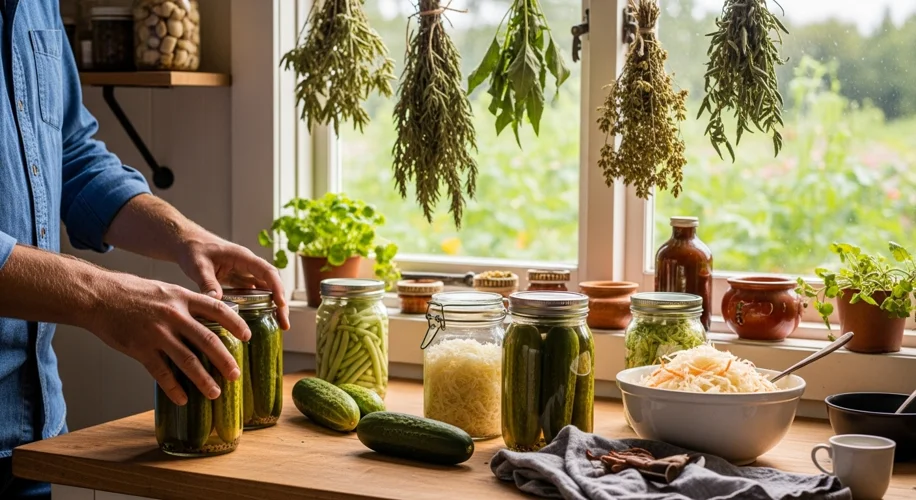Ever stared at a pile of homegrown tomatoes, a bushel of beans, or a mountain of zucchini and thought, “Now what?” As a gardener, there’s nothing quite like the thrill of a bountiful harvest. But that thrill can quickly turn into a race against time before all that beautiful produce goes bad. That’s where the wisdom of our ancestors comes in. They didn’t have refrigerators or freezers, but they were absolute masters of making food last. And guess what? Their techniques are just as relevant – maybe even more so – for us today, especially if you’re into sustainable living.
I’ve been on a journey to really dig into these ancient methods. It’s not just about saving food; it’s about reducing waste, saving money, and connecting with the rhythm of the seasons. Plus, there’s something incredibly satisfying about opening a jar of pickled beans in the dead of winter, knowing they came from your own patch.
Pickling: That Tangy Time Capsule
Pickling is probably one of the most well-known old-school techniques. It’s simple, really: you use an acidic solution, usually vinegar, along with salt and spices, to preserve food. The acid creates an environment where spoilage bacteria can’t thrive, while the salt draws out moisture and adds flavor. It’s been around for thousands of years – think about those Roman soldiers munching on pickled cucumbers!
My first foray into pickling was with cucumbers, of course. I remember feeling so proud of my first batch of dill pickles, even if they were a little… firm. Now, I pickle everything from green beans (dilly beans are a game-changer for snacking!) to radishes, which turn surprisingly mild and beautiful when pickled. Pickling adds a fantastic zing to salads, sandwiches, or just as a crunchy side. It’s an easy way to capture that fresh garden flavor and enjoy it months later.
Drying: Nature’s Dehydrator
Before fancy electric dehydrators, folks relied on the sun and air to preserve food. Drying is all about removing moisture, which is what microbes need to grow. Less water means no spoilage. It’s incredibly energy-efficient if you live in a sunny, dry climate, or even if you just have a sunny windowsill for herbs.
I’ve dried countless bunches of herbs from my garden – basil, oregano, thyme. Just tie them in small bundles and hang them upside down in a cool, dry place. The aroma alone is a reward! Last summer, I had an abundance of cherry tomatoes, so I sliced them thinly and dried them in my dehydrator (though a sunny spot with good airflow works too). Once you have these dried tomatoes, the possibilities are endless! I love making a robust sun-dried tomato pesto or rehydrating them for sauces and stews. Dried apples, plums, and even mushrooms are fantastic for extending the pantry. It’s amazing how concentrated the flavors become.
Fermenting: The Gut-Friendly Magic
This one feels a little more like mad science, but it’s pure, delicious magic. Fermentation uses beneficial microorganisms (like good bacteria and yeasts) to transform food. These microbes break down sugars, producing acids, gases, and alcohol, which not only preserve the food but also enhance its flavor and often its nutritional value. Think sauerkraut, kimchi, or kombucha.
My first attempt at sauerkraut was… memorable. I followed a simple recipe of shredded cabbage and salt, packed it into a jar, and waited. The bubbling was fascinating! Trust me, I’ve had my share of kraut explosions in the kitchen when the gas built up too much, but it’s all part of the learning curve. The tangy, crunchy result was worth every bubbly moment. Fermented foods are incredible for gut health, packed with probiotics, and they bring an amazing depth of flavor to meals. I often add a spoonful of homemade sauerkraut to a bowl of warm lentils or serve it alongside roasted veggies.
Why Bother with the Old Ways?
In our modern world of convenience, it might seem like a lot of effort. But these ancient methods offer so much more than just preserved food. They connect us directly to our food source. They reduce our reliance on industrial processes and packaging. They cut down on food waste, which is a huge win for sustainability. And honestly, there’s a deep satisfaction in knowing you’re carrying on traditions that have sustained humanity for millennia.
So, if your garden is overflowing, or you just want to make your farmers market haul last longer, I encourage you to try one of these methods. Start small. Pickle some radishes. Dry some herbs. Make a small batch of sauerkraut. You might just find a new favorite hobby – and a delicious way to enjoy the fruits (and veggies!) of your labor year-round.
What are your favorite preservation methods? Or what are you excited to try? Let me know in the comments below!

